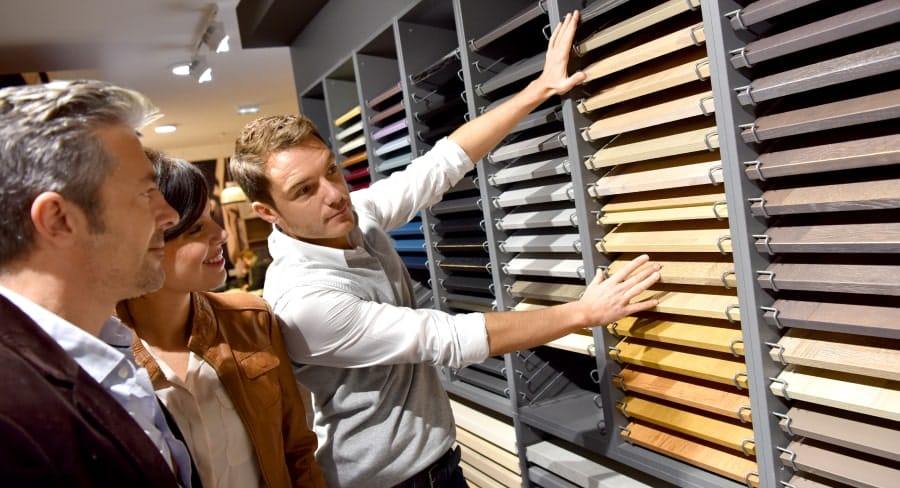4 Game-Changing Home Improvement Industry Trends You Need To Know

In today's rapidly evolving home improvement industry, staying ahead of the curve and effectively responding to the latest trends have become crucial for businesses to thrive.
Home improvement retailers in 2023 are incorporating cutting-edge technologies, embracing the empowering Do-It-Yourself (DIY) movement, and continually adapting to meet the ever-changing preferences of their customers. By staying informed and adaptable, businesses not only drive growth, but also foster innovation and maintain their relevance in the fiercely competitive home improvement sector.
Join us as we explore four trends that are reshaping the home improvement industry and discover how you can position your business to seize emerging opportunities.
1. Creation of personalized and customized shopping experiences
Personalization and customization have become key drivers in the home improvement retail industry. Homeowners today do not want the readily available colors and patterns in store. They want to make living spaces that reflect their unique style, especially with the variety of choices from online retailers.
In response, home improvement retailers like Home Depot are providing personalized design consultations, where professionals work closely with customers to understand their vision and recommend customized solutions. This allows homeowners to create spaces that truly feel like their own, enhancing satisfaction with their home.
By embracing personalization and customization, home improvement retailers empower customers to bring their visions to life. From aesthetics to functionality, personalized products enable homeowners to create spaces that reflect their individuality and meet their specific needs. As this trend continues to shape the industry, retailers offering extensive customization options and seamless design experiences are well-positioned to cater to the evolving demands of modern homeowners.
In the realm of home improvement, personalization goes beyond just custom product offerings and aesthetics. Retailers have stepped up their game by offering tailored solutions that cater to the unique needs and lifestyles of their shoppers. Today, retailers understand the significance of accommodating diverse customer groups and strive to provide personalized shopping experiences that align with the specific requirements of each individual.
Increasing industry personalization can be seen through the Lowe’s enhanced shopping experience for pro customers that launched across its various retailers in the United States and Canada. Since a majority of Lowe’s customers are professionals, the “New Home for Pros' ” is tailored towards making their shopping experience as time and money saving as can be.
This renovation brings new home improvement services such as The Pro Zone for professionals to find popular items right inside the Pro entrance, Pro Trailer Parking with extended spots for vehicles with trailers, and a Dedicated Pro Checkout with a team of associates ready to serve them in a moment’s notice.

2. Increased demand for smart home technology
As younger generations are reaching the homebuyer stage, the demand for smart home technology is on the rise. A recent study revealed that 7 in 10 homebuyers are looking for a home with smart technology and 78% would pay more for a home with these devices.
Recognizing the transformative impact of smart home technology on our living spaces, retailers are capitalizing on this growing trend in home improvement spending. To do so effectively, they are diligently expanding their offerings, providing a diverse array of smart devices and systems aimed at enhancing convenience, efficiency, and security within homes.
From smart thermostats that learn and adapt to homeowners' temperature preferences to voice-activated assistants that control lighting, appliances, and entertainment systems, retailers are providing homeowners with the tools to create fully connected and automated environments. Giving homeowners greater comfort, energy savings, and peace of mind.
Retailers go beyond merely selling standalone smart devices; they actively assist homeowners in creating a unified "smart home" system. This involves the seamless integration of multiple devices, and retailers play a pivotal role in making the process easier. They achieve this by curating a selection of compatible products and providing valuable guidance on system integration.
Furthermore, these retailers are placing a strong emphasis on highlighting the advantages of smart home technology. They accomplish this by offering in-store demonstrations, workshops, and online resources. By offering these resources, they not only enhance their revenue streams but also bolster the credibility of their brand. This commitment to education demonstrates their expertise and dedication to helping customers make informed decisions, further solidifying their reputation as trusted authorities in the smart home technology market.
Consumers are looking for convenience, efficiency, and better living experiences that smart technology offers. Home improvement retailers can take advantage of this home improvement trend to increase their market share while also helping homeowners benefit from a connected and automated home.

3. Implementation of virtual reality and augmented solutions
Home improvement stores are leveraging innovative technology to enhance the customer experience. Virtual and augmented reality tools provide customers and retail executives with a way to see how products would look in their homes or stores prior to physical investment. This increases engagement, eliminates uncertainty and enables more informed decisions.
Innovative technologies such as virtual reality and augmented reality help brands create value-added experiences. One example can be seen from Ikea, who created a furniture visualization app that allows customers to view how different pieces of furniture would fit in their home. Enabling shoppers to design and visualize their living spaces without needing to travel to their brick-and-mortar store.
Lowe's, a top home improvement retailer, has demonstrated the potential of virtual reality (VR) technology within its operations through their innovative Holoroom How To training lab. The training lab allows employees to virtually practice tasks such as tiling, plumbing, and other do-it-yourself (DIY) projects in a realistic and interactive virtual environment. This cutting-edge training approach enables employees to gain practical experience and confidence before applying their skills in real-world customer interactions.
There are numerous new technologies that home improvement retailers can use to explore the benefits of VR. One such application is ReadySet, a VR software that includes virtual big box home improvement stores like Home Depot and Lowes for efficient store planning and innovation. These retail digital twins provide fast and cost-effective store labs for building new layout or product concepts, developing merchandising planograms and conducting shopper research.
ReadySet's virtual reality capabilities offer a significant advancement over traditional retail planning methods by providing brands with boundless space for innovation and incorporating built-in eye-tracking for advanced data collection. Unlike traditional consumer habit studies, where researchers are confined to observing feedback, virtual reality research overcomes these limitations by accurately tracking crucial subconscious behaviors, including eye movements. The integration of infrared lighting in virtual reality headsets enables precise and in-depth eye-tracking feedback.
By leveraging virtual reality, brands gain insights into which items consumers look at, the duration of their attention, and patterns of exploration through aisle and path heat mapping. This comprehensive understanding of consumer behavior empowers retailers to make more informed decisions and optimize their store layouts for enhanced customer experiences.

4. Rising adoption of DIY in home improvement
The exponential rise of e-commerce sales channels has triggered unprecedented market growth for do-it-yourself (DIY) home renovation solutions. This surge in demand has propelled the DIY home improvement market size, surpassing 290 billion in 2020, with a projected CAGR of 4.5% through 2027. As homeowners increasingly seek to save costs, derive personal satisfaction, and infuse their unique touch into their projects, the trend of taking on DIY home improvement endeavors continues to gain traction.
In response to this trend, home improvement retailers are actively adapting their strategies. They recognize the demand for DIY and remodeling projects and are stepping up to support customers through valuable resources and education. By empowering homeowners with the necessary knowledge and skills, these retailers enable customers to confidently undertake a diverse array of projects. This approach not only aligns with the evolving needs and preferences of homeowners but also cultivates a mutually beneficial relationship between retailers and DIY enthusiasts, fostering loyalty and customer satisfaction.
To cater to the increasing demand for DIY education, numerous retailers offer a wide range of educational resources, whether in virtual or physical formats. These resources encompass workshops, how-to videos, and informative content covering various topics such as painting techniques, tile installation, and woodworking. By providing accessible DIY resources, retailers enable a broader audience to learn at their own pace and acquire the skills needed for their home improvement projects.
This promotion of DIY education by home improvement retailers serves as a catalyst for empowering customers. It fosters a sense of self-reliance and encourages homeowners to channel their creativity and effort into transforming their living spaces. As a result, customers are not only equipped with the necessary knowledge and skills but also derive a more fulfilling experience throughout the DIY home improvement journey.
DIY home improvement education reflects the increasing desire of homeowners to take charge of enhancing their living spaces. In response, retailers should actively empower homeowners by promoting a DIY culture and facilitating access to valuable educational materials. This shift not only benefits customers by enabling them to undertake more home improvement projects, but it also positions home improvement retailers as trusted advisors and partners in the success of their customers' DIY endeavors.

In conclusion, being aware of and adapting to the game-changing trends in the home improvement industry is vital to thrive in this dynamic market. Personalization enhances shopping experiences, while smart home technology improves consumers' home life. The utilization of virtual reality and augmented reality elevate user experiences and decision making. Lastly, by embracing the DIY trend and education, retailers can strengthen their relationship with customers and become instrumental in their journey towards creating the spaces they envision.
By staying informed and embracing these trends, businesses can position themselves as leaders in the industry, meet evolving consumer demands, and drive growth in the competitive home improvement market.
Subscribe to our newsletter
Get our blogs and the latest retail news delivered to your inbox monthly.
Recent Posts
Candy, Bar, and Snack Industry use VR to Keep Up with Consumers
Discover the snack trends of 2024 that are pushing the snack bar market and candy industry to innovate and evolve using cutting-edge technology. The Convenience Store News 2024 Industry Deep Dive revealed numerous snack food industry trends, highlighting a shift toward healthier snacking options and a growing preference for savory flavors. As various snack categories…
Ice Cream Category Leverages VR Innovation for Sales Growth
Learn about new virtual reality retail planning and research solutions aimed to assist ice cream industry growth amid recent sales decline. The ice cream industry has faced a noticeable decline in unit sales since the pandemic, as reported by Kroger’s retail data science company 84.51˚. Their ice cream industry analysis showcased inflation driving a modest…
8 Applications of Virtual Reality Shopper Market Research Studies
Discover several types of consumer packaged goods (CPG) market research that can be conducted in virtual reality store environments. Virtual reality (VR) shopper market research software solutions leverage immersive technology to create simulated environments where researchers can study behaviors, reactions, and interactions in a controlled yet realistic setting. Virtual reality market research for retail business is…




[…] https://readysetvr.com/2023/05/26/4-game-changing-home-improvement-industry-trends-you-need-to-know/ […]